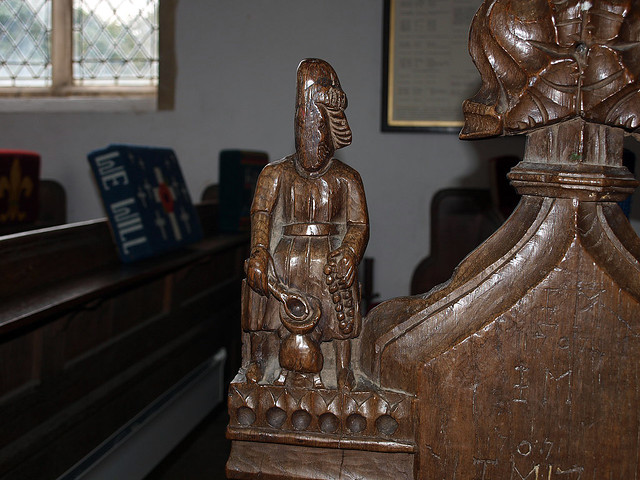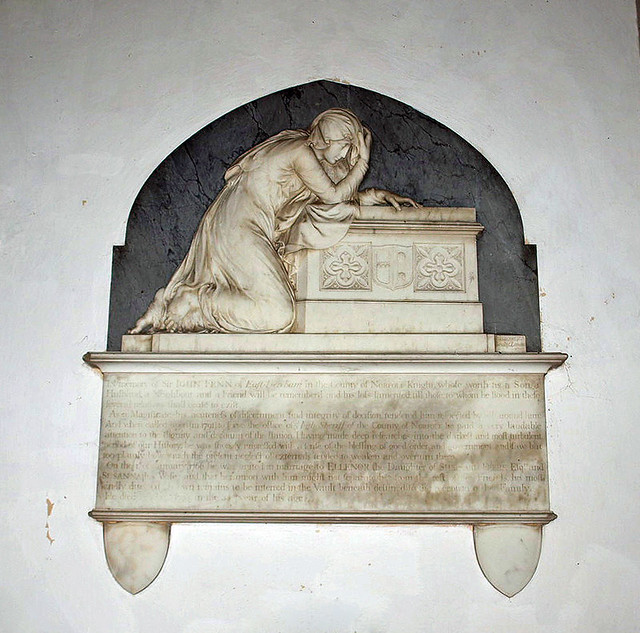Truth be told there's nothing much of interest here - some bench ends, Sir John Fenn's monument and the pulpit but otherwise all rather airbrushed and sterile [or at least I thought so]. Hats off though for being open.
ST BARTHOLOMEW. Partly of the early C14, partly Perp. The W tower is of the earlier date. Bell-openings with Y-tracery, but that to the E a quatrefoil in a circle. The chancel S doorway and nave S doorway also of the earlier date. The rest of the S side Perp. N side all Perp with a simple brick porch. The S porch is the only ornate piece. It has flushwork panelling, niches l. and r. of the entrance, and a parapet nicely decorated with alternating quatrefoils placed upright and diagonally. - FONT. Octagonal. Simple. The base is of two steps, the upper in the form of a Maltese Cross. - FONT COVER. Perp, a pinnacle, but not a high one. The principal decoration is some oblong panels with squares flanked by little arches. In the squares interesting combination of squares and circles, e.g. a square set within a diagonally placed square set within a square. All three touch. Or a circle set within a square set within a circle set within a square. All squares and circles touch. It all looks connected with the masons’ mysteries of proportions. - BENCH ENDS. With tracery and poppy-heads. On the arms figures seated not towards the E as usual but towards the gangway. - STAINED GLASS. Some, in the E window. - MONUMENTS. John Williamson d. 1781 by John Golden of Holborn. A pretty tablet of white and pink marble, neo-classical in style. No figures at all. - Sir John Fenn, editor of the Paston letters, signed by John Bacon, 1797. With a woman kneeling over an urn.
FINNINGHAM. There is a pleasant air of order about this wide street and well-kept churchyard, where the 15th century battlemented tower rises among the trees. There was once a Saxon church here, and, though all traces of it had long disappeared, a little clay arch of the Saxon tower has been uncovered, linking it with the fine church of today. Two crosses stand out on the gable of the chancel and there are mass dials on buttresses. The 15th century font has its original wooden cover, high and elaborately carved. A choice bit of Jacobean carving is let into one of the choir-stalls, and the battered bench-ends have been made good. Some bits of old glass in the east window show small figures of saints in the tracery.
There are memorials of the Freres on every side; they came to Suffolk in the 13th century and have lived at Finningham since 1598. Some have been rectors; and Sir Henry Bartle Frere was in the Indian Civil Service, and was thanked by Parliament for the relief work he organised during the Mutiny. In 1872 he was sent to Zanzibar to enquire into the slave trade, and so successful were his interviews with the Sultan that he brought home a treaty abolishing the slave traffic of which Zanzibar was the centre. A most difficult task was then allotted to him, for he was sent to South Africa as High Commissioner to bring about a confederation of the South African colonies. The Transvaal had just been brought under English suzerainty, the Kaffir chiefs were in revolt, and Cetewayo was assembling his Impis in Zululand. Bartle Frere showed great personal courage and earnestness in his endeavours to solve the difficult problems, but his declaration of war on the Zulus led to his being recalled by the Home Government, and he devoted the remainder of his life to advocating good causes in England. Frere was a man who lived to do his duty; and when he was asked one day what would remain when he was superseded in the midst of his work in South Africa, his simple reply was: “My integrity.” One brass here records the names of members of his family from 1736 to 1918.
In a window in memory of Hatley Frere, who died in 1878, is the family group of Lois and Eunice reading the Bible to the youthful Timothy. A kindly bequest mentioned on a tablet was of money left in 1766 to teach four children to spin and to sew, and to buy four strong coats “to be turned up with black” for four poor men. In the porch two windows with shields and borders were given by Constantine Frere, rector here for 58 years to 1905. A tenderly worded inscription to the memory of his wife is in the porch
through which she loved to pass, among a people whom she loved, into the earthly Temple of Him she loved above all, into whose closer presence she entered through the door Christ Jesus, to go no more out.
There is some remarkably fine carving on the modern gallery, and an exquisite canopied reredos, with festoons of vine leaves and gilded earns of corn. Robert de Finningham, a 15th century follower of St Francis, was born here; he wrote many scholarly works in Latin. Here sleeps in the chancel Sir John Fenn, High Sheriff of Suffolk, a well-known antiquary and editor of the Paston letters, “who made deep researches into the darkest and most turbulent period of our history.” He died in 1794, and there is in his memory a graceful sculpture by John Bacon of a woman kneeling in grief. An inscription to his wife declares that many rising generations will join in thankfulness for her support of the improved system of education.



No comments:
Post a Comment